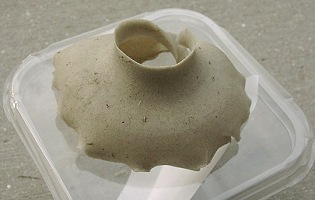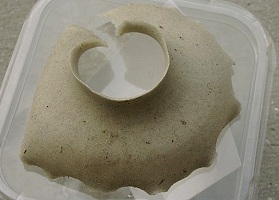

Data:
I found this in Estero Bay Florida Gulf. There are many of these things
all over some areas. The ones that I see are found in about 1 to 3 feet
of water. They are about 4 inches in diameter and 2 inches high. They
are soft and break apart easily.
Thanks for any help.
Steve R.
Send thoughts and
ideas to: Steve
Email: sar3195@comcast.net
Probable ID:
- Neverita
duplicatus
(Say, 1822)
Shark Eye or Moon
snail
Syn. Polinices duplicatus
Possible ID:
-
Neverita duplicata (Say, 1822) Sand Egg Collar.
Avril B. -
These are very common in southeast Florida, in the sand inside the third reef at 65 fsw. I always assumed they were Sharkeye (Polinices duplicatus) eggs, but I have never seen one being made."Collectible Florida Shells" by R. Tucker Abbott also ascribes them to P. duplicatus.
Mike G. -
I have found sand collars in New England cover with the egg cases of the oyster drills. Could this be what you have found? If not from the drills ( Urosalpinx cinerea ) maybe something similar. A good book to check out egg cases in I found is the( A Golden Field Guide ) A Guide to Field Identification Seashells of North America. According to this book the egg mass of the moon snails is a gelatinous mass surrounded by the protective sand collar. Hope this is of some help.
Toni -
The thin, flexible walls flare to form an upright cylindrical crown and having a wavy (plicated) basal margin; these are characteristic of the Shark Eye moonsnail, Neverita duplicata (Say, 1822).
Egg collars are unique to the family Naticidae and no other prosobranch. A very useful feature of differentiating species is the uniqueness of moonsnail egg cases, sand-encrusted gelatinous ribbons (Giglioli, 1955) and their resulting larval forms- planktonic/ crawl away (Bouchet and Waren (1993).
Giglioli (1955) developed a scheme of classification for naticid egg collars. The egg collars of Atlantic intertidal species, Polinices heros, P. duplicata, and P. triserata, were described by Gigliola 1952 and 1955 and others."
Rick H. -
According to Beatrice E. Winner in A Field Guide to Molluscan Spawn, vol 1. (1987), the naticid sand collar is a single-layered structure of sand grains held together by a gelatinous matrix. The sand grain size is specific to the species - thus the grains in a Natica canrena collar are larger than those in a Neverita duplicata collar. The eggs are minute and are embedded in the collar. If the collar is held up to a strong light (back lit), the egg cases can be seen as numerous transparent sections in the collar. Tom E.
-
They're egg cases produced by naticid gastropods (moon snails). The most common genus is Polinices. These same snails produced the tapered drill holes you find in clams; they're predators that drill their prey then digest the clam's adductor muscles until they pop open. The circular opening at the top of the of skirt is where the snail's aperture sits; the skirt is then produced around the shell; when done, the snail crawls away. Dr. Michael S.

Neverita duplicatus
(Say, 1822)
Shark Eye or Moon snail
Marine Biological Laboratory Woodshole:
"A large, predatory, marine snail that feeds on other mollusks. It drills through the shells of it's prey with it's radula, leaving a small bevelled hole. The mantle of this snail is inflated with seawater and can be spread over an enormous area as the animal moves across the sandy flats and bars that are it's typical habitat. The eggs of this animal are mixed with sand and cemented into "sand collars" which are often seen on tidal flats..."
"The sand egg
collars (actually a mixture of mucus, sand and eggs) produced by the Shark
Eye Moon Snail are a common fixture on the open Atlantic beaches of northeast
Florida. As the species produces these collars offshore in deeper water,
they are usually only found washed ashore following heavy seas...."
